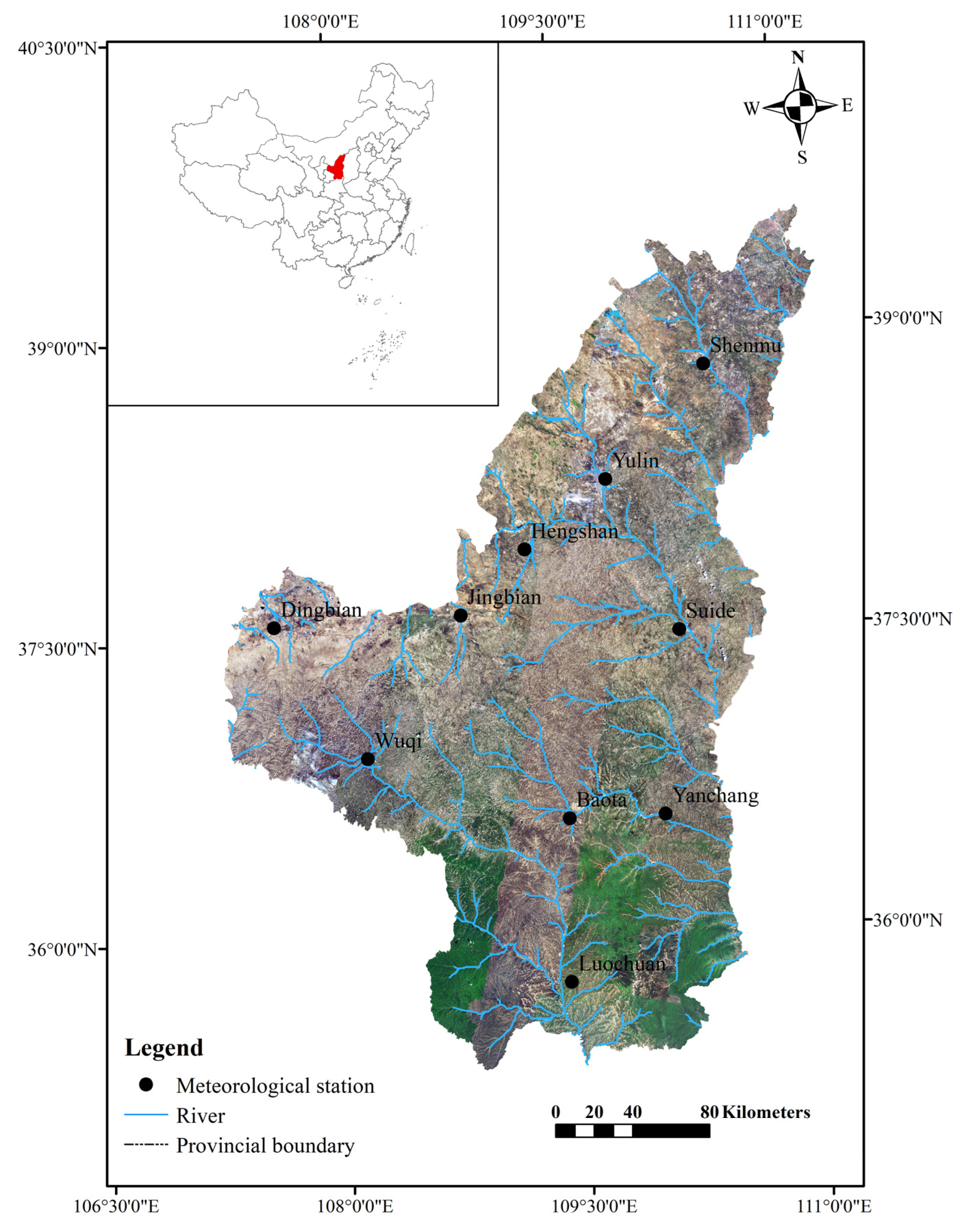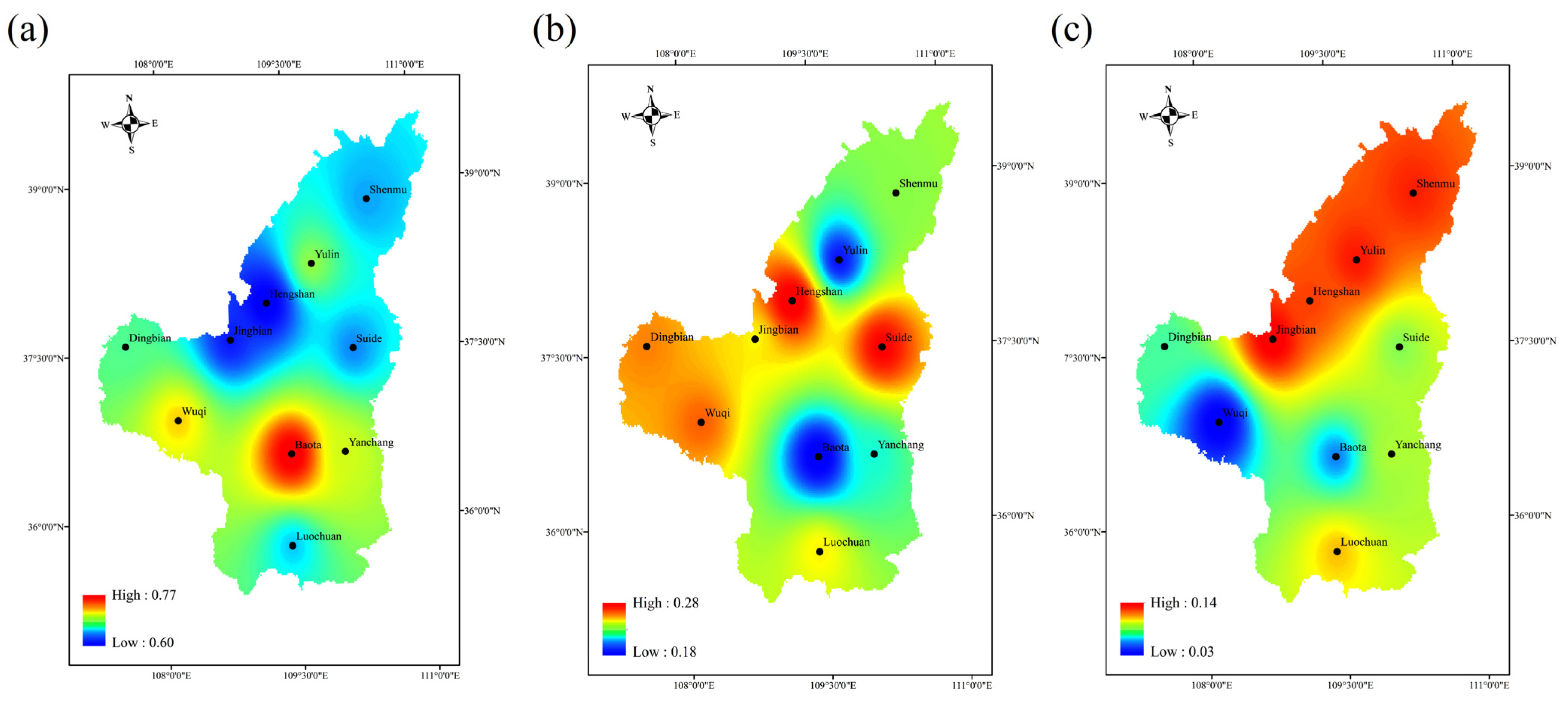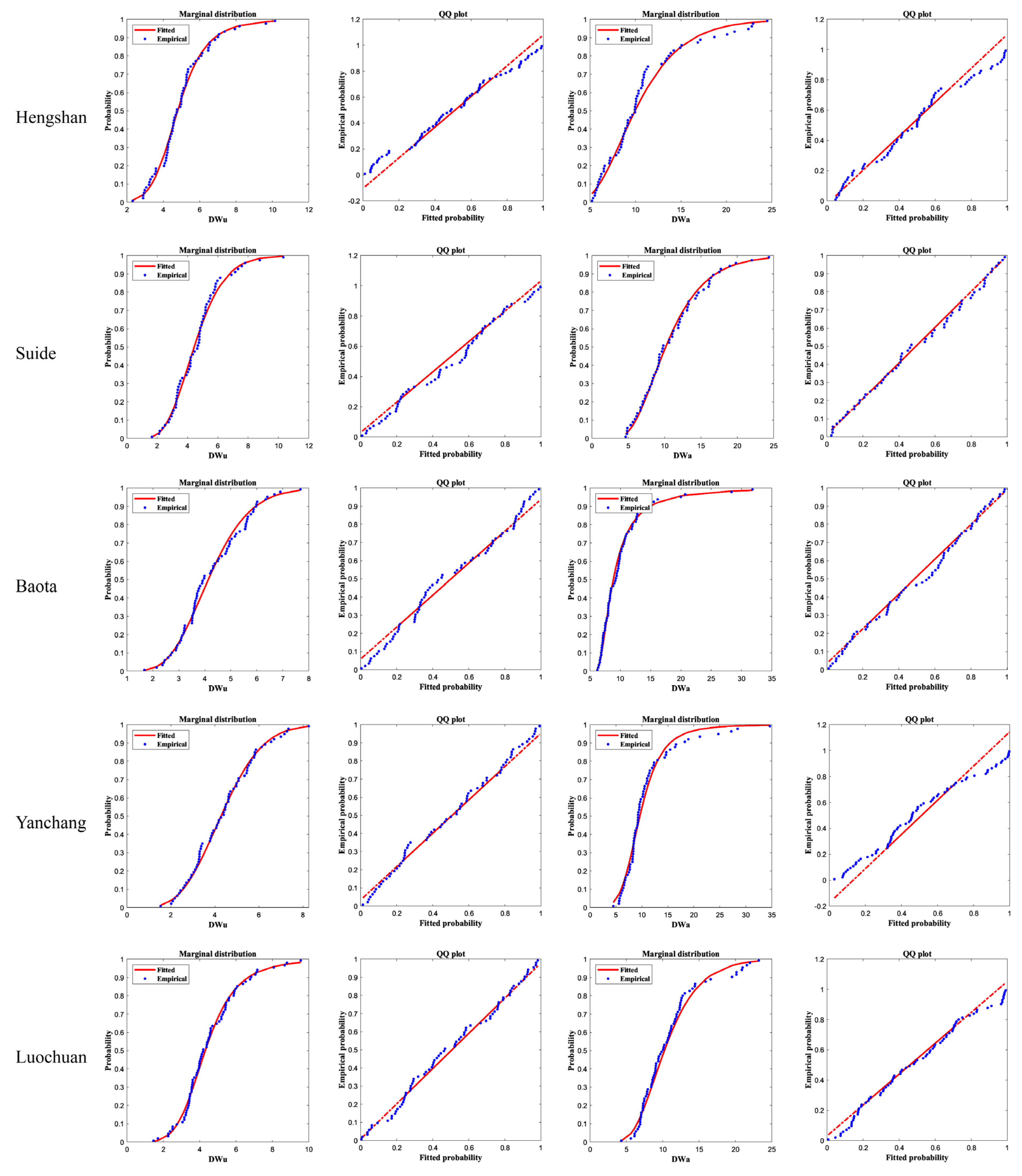Analysis of Characteristics of Dry–Wet Events Abrupt Alternation in Northern Shaanxi, China
Abstract
:1. Introduction
2. Study Area and Data
3. Methodology
3.1. Daily Dry–Wet Events Abrupt Alternation Index DWAAI
3.2. Identification of Characteristic Variables of Dry–Wet Events Abrupt Alternation
3.3. Construct the Marginal Distribution Function of Characteristic Variables
3.4. Determination of Copula Function
3.5. Calculation of Return Periods
4. Results
4.1. DWAAI Index Applicability Verification
4.2. Spatial Distribution Characteristics of Dry–Wet Events Abrupt Alternation
4.3. Determination of Copula
4.3.1. Correlation Analysis of Dry–Wet Events Abrupt Alternation Characteristic Variables
4.3.2. Determine the Appropriate Marginal Distribution Function
4.3.3. Determine the Appropriate Copula
4.4. Joint Probability Distribution
4.5. Joint Return Period
5. Discussion and Conclusions
Author Contributions
Funding
Data Availability Statement
Acknowledgments
Conflicts of Interest
References
- Amirataee, B.; Montaseri, M.; Rezaie, H. Regional analysis and derivation of copula-based drought Severity-Area-Frequency curve in Lake Urmia basin, Iran. J. Environ. Manag. 2018, 206, 134–144. [Google Scholar] [CrossRef] [PubMed]
- Feng, Y.; Li, Y.; Zhang, Z.; Gong, S.; Liu, M.; Peng, F. Multi-factor joint return period of rainstorms and its agricultural risk analysis in Liaoning Province, China. Geomat. Nat. Hazards Risk 2019, 10, 1988–2008. [Google Scholar] [CrossRef] [Green Version]
- Liu, Y.; Li, Y.; Li, L.; Chen, C. Spatiotemporal Variability of Monthly and Annual Snow Depths in Xinjiang, China over 1961–2015 and the Potential Effects. Water 2019, 11, 1666. [Google Scholar] [CrossRef] [Green Version]
- Tosunoglu, F.; Gürbüz, F.; İspirli, M.N. Multivariate modeling of flood characteristics using Vine copulas. Environ. Earth Sci. 2020, 79, 182–198. [Google Scholar] [CrossRef]
- Gaume, E.; Bain, V.; Bernardara, P.; Newinger, O.; Barbuc, M.; Bateman, A.; Blaskovicova, L.; Bloschl, G.; Borga, M.; Dumitrescu, A.; et al. A compilation of data on European flash floods. J. Hydrol. 2009, 367, 70–78. [Google Scholar] [CrossRef] [Green Version]
- Lesk, C.; Rowhani, P.; Ramankutty, N. Influence of extreme weather disasters on global crop production. Nature 2016, 529, 84–87. [Google Scholar] [CrossRef] [PubMed]
- Liao, Q.; Yu, G.; Jiang, W.S.; Lu, C.X.; Ma, Y.; Liu, K.X.; Lin, Q.; Wang, Y.P. Research on the Risk Assessment of Qingdao Marine Disaster Based on Flooding. Sustainability 2019, 11, 468. [Google Scholar] [CrossRef] [Green Version]
- Spinoni, J.; Naumann, G.; Carrao, H.; Barbosa, P.; Vogt, J. World drought frequency, duration, and severity for 1951–2010. Int J Clim. 2014, 34, 2792–2804. [Google Scholar] [CrossRef] [Green Version]
- Trenberth, K.E.; Dai, A.G.; Van Der Schrier, G.; Jones, P.D.; Barichivich, J.; Briffa, K.R.; Sheffield, J. Global warming and changes in drought. Nat. Clim. Chang. 2014, 4, 17–22. [Google Scholar] [CrossRef]
- Kastridis, A.; Stathis, D. Evaluation of Hydrological and Hydraulic Models Applied in Typical Mediterranean Ungauged Watersheds Using Post-Flash-Flood Measurements. Hydrology 2020, 7, 12. [Google Scholar] [CrossRef] [Green Version]
- Aitkenhead, I.; Kuleshov, Y.; Watkins, A.B.; Bhardwaj, J.; Asghari, A. Assessing agricultural drought management strategies in the Northern Murray–Darling Basin. Nat. Hazards 2021, 34, 1–31. [Google Scholar]
- Mohammadi, M.; Darabi, H.; Mirchooli, F.; Bakhshaee, A.; Haghighi, A.T. Flood risk mapping and crop-water loss modeling using water footprint analysis in agricultural watershed, northern Iran. Nat. Hazards 2020, 33, 1–19. [Google Scholar] [CrossRef]
- Zarei, A.R.; Moghimi, M.M.; Koohi, E. Sensitivity Assessment to the Occurrence of Different Types of Droughts Using GIS and AHP Techniques. Water Resour. Manag 2021, 35, 1–23. [Google Scholar]
- Chang, X.; Xu, Z.; Zhao, G.; Cheng, T.; Song, S. Spatial and temporal variations of precipitation during 1979–2015 in Jinan City, China. J. Water Clim. Chang. 2018, 9, 540–554. [Google Scholar] [CrossRef]
- Zhang, J.; Sun, F.; Liu, W.; Liu, J.; Wang, H. Spatio-temporal patterns of drought evolution over the Beijing-Tianjin-Hebei region, China. J. Geogr. Sci. 2019, 29, 863–876. [Google Scholar] [CrossRef] [Green Version]
- Li, K.; Tong, Z.; Liu, X.; Zhang, J.; Tong, S. Quantitative assessment and driving force analysis of vegetation drought risk to climate change: Methodology and application in Northeast China. Agric. For. Meteorol. 2020, 282–283, 107865. [Google Scholar]
- Rui, Z.; Guo, C.Q.; Fu, Q.J.; Pan, L.Y. Study on the Drought and Flood Disasters Formation Mechanism in Karst Regions of Middle Guangxi. Procedia Eng. 2012, 28, 277–281. [Google Scholar] [CrossRef] [Green Version]
- Gall, M. The suitability of disaster loss databases to measure loss and damage from climate change. Int. J. Glob. Warm. 2015, 8, 170–190. [Google Scholar] [CrossRef]
- Rzepka-Plevneš, D.; Krupa-Małkiewicz, M.; Kurek, J.; Smolik, M. Effects of water deficits on development and yield of rye varieties differing in tolerance to drought at seedling stage. J. Food Agric. Environ. 2009, 7, 492–495. [Google Scholar]
- Yu, J.; Jiang, M.; Guo, C. Crop Pollen Development under Drought: From the Phenotype to the Mechanism. Int J Mol Sci. 2019, 20, 1550. [Google Scholar] [CrossRef] [Green Version]
- Shi, Y.; Zhai, G.; Zhou, S.; Lu, Y.; Chen, W.; Deng, J. How Can Cities Respond to Flood Disaster Risks under Multi-Scenario Simulation? A Case Study of Xiamen, China. Int. J. Environ. Res. Public Health 2019, 16, 618. [Google Scholar] [CrossRef] [PubMed] [Green Version]
- Zhu, Y.; Li, L.; Zhao, Y.; Liang, Z.; Li, H.; Wang, L.; Wang, Q. Regional comprehensive drought disaster risk dynamic evaluation based on projection pursuit clustering. Water Policy 2018, 20, 410–428. [Google Scholar] [CrossRef]
- Yan, D.; Han, D.; Wang, G.; Yuan, Y.; Hu, Y.; Fang, H. The evolution analysis of flood and drought in Huai River Basin of China based on monthly precipitation characteristics. Nat. Hazards 2014, 73, 849–858. [Google Scholar] [CrossRef]
- Li, C.; Wang, R.H.; Xu, J.X.; Luo, Y.J.; Tan, M.L.; Jiang, Y.L. Analysis of meteorological dryness/wetness features for spring wheat production in the Ili River basin, China. Int. J. Biometeorol. 2018, 62, 2197–2204. [Google Scholar] [CrossRef]
- Shi, W.Z.; Huang, S.Z.; Liu, D.F.; Huang, Q.; Han, Z.M.; Leng, G.Y.; Wang, H.; Liang, H.; Li, P.; Wei, X.T. Drought-flood abrupt alternation dynamics and their potential driving forces in a changing environment. J. Hydrol. 2021, 597, 126179. [Google Scholar] [CrossRef]
- Shan, L.J.; Zhang, L.P.; Song, J.Y.; Zhang, Y.J.; She, D.X.; Xia, J. Characteristics of dry-wet abrupt alternation events in the middle and lower reaches of the Yangtze River Basin and the relationship with ENSO. J. Geogr. Sci. 2018, 28, 1039–1058. [Google Scholar] [CrossRef] [Green Version]
- Shen, B.Z.; Zhang, S.X.; Yang, H.W.; Wang, K.; Feng, G.L. Analysis of characteristics of a sharp turn from drought to flood in the middle and lower reaches of the Yangtze River in spring and summer in 2011. Acta Phys. Sin. 2012, 61, 109202. [Google Scholar]
- Wang, C.H.; Li, K.C.; Santisirisomboon, J. Wave activities characteristics during a sudden sharp drought-flood turn event in 2011 in East China. Int. J. Clim. 2021, 41, 3469–3480. [Google Scholar] [CrossRef]
- Ji, Z.H.; Li, N.; Wu, X.H. Threshold determination and hazard evaluation of the disaster about drought/flood sudden alternation in Huaihe River basin, China. Theor. Appl. Climatol. 2018, 133, 1279–1289. [Google Scholar] [CrossRef]
- Yang, Y.H.; Weng, B.S.; Bi, W.X.; Xu, T.; Yan, D.M.; Ma, J. Climate Change Impacts on Drought-Flood Abrupt Alternation and Water Quality in the Hetao Area, China. Water 2019, 11, 652. [Google Scholar] [CrossRef] [Green Version]
- Wu, Z.W.; Li, J.P.; He, J.H.; Jiang, Z.H. Large-scale atmospheric singularities and summer long-cycle droughts-floods abrupt alternation in the middle and lower reaches of the Yangtze River. Chin. Sci. Bull. 2006, 51, 2027–2034. [Google Scholar] [CrossRef]
- Gao, Y.; Hu, T.S.; Wang, Q.; Yuan, H.W.; Yang, J.W. Effect of Drought-Flood Abrupt Alternation on Rice Yield and Yield Components. Crop Sci. 2019, 59, 280–292. [Google Scholar] [CrossRef]
- Xiong, Q.Q.; Deng, Y.; Zhong, L.; He, H.H.; Chen, X.R. Effects of Drought-Flood Abrupt Alternation on Yield and Physiological Characteristics of Rice. Int. J. Agric. Biol. 2018, 20, 1107–1116. [Google Scholar]
- Yang, S.Y.; Wu, B.Y.; Zhang, R.H.; Zhou, S.W. Relationship between an abrupt drought-flood transition over mid-low reaches of the Yangtze River in 2011 and the intraseasonal oscillation over mid-high latitudes of East Asia. Acta Meteorol. Sin. 2013, 27, 129–143. [Google Scholar] [CrossRef]
- Zhang, Z.Z.; Yuan, Y.J.; Shen, D.F.; Fan, H. Analysis of drought-flood abrupt alternation of tobacco based on precipitation and soil ponding in siuwen china. Appl. Ecol. Environ. Res. 2019, 17, 12271–12286. [Google Scholar] [CrossRef]
- Zhao, Y.; Weng, Z.H.; Chen, H.; Yang, J.W. Analysis of the Evolution of Drought, Flood, and Drought-Flood Abrupt Alternation Events under Climate Change Using the Daily SWAP Index. Water 2020, 12, 1969. [Google Scholar] [CrossRef]
- Cao, Y.; Liu, J.; Wang, X.; Wang, Q. Drought-and-flood period, mutation point and trend analysis in Huang-Huai-Hai River Basin. Arid Land Geogr. 2016, 39, 275–284. [Google Scholar]
- Cheng, Z.; Xu, M.; Luo, L.; Ding, X. Climate Characteristics of Drought–flood Abrupt Change Events in Huaihe River Basin. J. China Hydrol. 2012, 32, 73–79. [Google Scholar]
- Liu, Y.; Chen, S.J.; Sun, H.W.; Gui, D.W.; Xue, J.; Lei, J.Q.; Zeng, X.F.; Lv, G.H. Does the long-term precipitation variations and dry-wet conditions exist in the arid areas? A case study from China. Quat. Int. 2019, 519, 3–9. [Google Scholar] [CrossRef]
- Hui-Mean, F.; Yusof, F.; Yusop, Z.; Suhaila, J. Trivariate copula in drought analysis: A case study in peninsular Malaysia. Theor. Appl. Climatol. 2019, 138, 657–671. [Google Scholar] [CrossRef]
- Sina, N.; Ahmad, S.; Mundher, Y.Z.; Shamsuddin, S. Copula based assessment of meteorological drought characteristics: Regional investigation of Iran. Agric. For. Meteorol. 2019, 276–277, 107611. [Google Scholar]
- Fan, H.; Zhang, Z.Z.; Wu, F.; Xu, J.X.; Shen, D.F.; Yuan, Y.J. Spatial and temporal evolution characteristics of drought-flood abrupt alternation in guizhou province in recent 50 years based on dwaai index. Appl. Ecol. Environ. Res. 2019, 17, 12227–12244. [Google Scholar] [CrossRef]
- Kastridis, A.; Kirkenidis, C.; Sapountzis, M. An integrated approach of flash flood analysis in ungauged Mediterranean watersheds using post-flood surveys and unmanned aerial vehicles. Hydrol. Process. 2020, 34, 4920–4939. [Google Scholar] [CrossRef]
- Moriasi, D.N.; Arnold, J.G.; Van Liew, M.W.; Bingner, R.L.; Harmel, R.D.; Veith, T.L. Model evaluation guidelines for systematic quantification of accuracy in watershed simulations. Trans. ASABE 2007, 50, 885–900. [Google Scholar] [CrossRef]
- Singh, J.; Knapp, H.V.; Arnold, J.G.; Demissie, M. Hydrological modeling of the iroquois river watershed using HSPF and SWAT. J. Am. Water Resour. 2005, 41, 343–360. [Google Scholar] [CrossRef]







| DWAAI | DWAA Level |
|---|---|
| >0~10 | None |
| >10~16 | Light |
| >16~24 | Moderate |
| >24 | Severe |
| Copula Type | Copula Formula | Parameter Range |
|---|---|---|
| Joe | ||
| Farlie-Gumbel-Morgenstern (FGM) | ||
| Burr | ||
| Marshall-Olkin | ||
| Fischer-Hinzmann | ||
| Roch-Alegre | ||
| Tawn |
| Station | Pearson | p Value |
|---|---|---|
| Yulin | 0.4858 | 0.0000 |
| Shenmu | 0.5310 | 0.0000 |
| Dingbian | 0.2501 | 0.0226 |
| Jingbian | 0.4803 | 0.0000 |
| Wuqi | 0.2751 | 0.0043 |
| Hengshan | 0.3570 | 0.0028 |
| Suide | 0.3509 | 0.0052 |
| Baota | 0.2696 | 0.0202 |
| Yanchang | 0.4046 | 0.0005 |
| Luochuan | 0.3280 | 0.0034 |
| Station | Variable | Function | Parameter | Value |
|---|---|---|---|---|
| Yulin | DWu | Generalized Pareto | k | −1.0184 |
| sigma | 5.8354 | |||
| theta | 1.7711 | |||
| DWa | Generalized Extreme Value | k | 0.3638 | |
| sigma | 2.8110 | |||
| mu | 8.3674 | |||
| Shenmu | DWu | Inverse Gaussian | mu | 4.7247 |
| lambda | 36.1879 | |||
| DWa | Generalized Extreme Value | k | 0.3392 | |
| sigma | 2.8688 | |||
| mu | 8.5185 | |||
| Dingbian | DWu | Gamma | a | 9.5575 |
| b | 0.4582 | |||
| DWa | Loglogistic | mu | 2.0924 | |
| sigma | 0.2440 | |||
| Jingbian | DWu | Gamma | a | 10.0449 |
| b | 0.4859 | |||
| DWa | Generalized Extreme Value | k | 0.3192 | |
| sigma | 2.9900 | |||
| mu | 8.3685 | |||
| Wuqi | DWu | Inverse Gussian | mu | 4.3756 |
| lambda | 39.5976 | |||
| DWa | Inverse Gussian | mu | 9.6819 | |
| lambda | 97.3290 | |||
| Hengshan | DWu | Loglogistic | mu | 1.5660 |
| sigma | 0.1611 | |||
| DWa | Generalized Pareto | k | −0.2260 | |
| sigma | 6.8166 | |||
| theta | 5.2102 | |||
| Suide | DWu | Gamma | a | 8.2977 |
| b | 0.5568 | |||
| DWa | Generalized Pareto | k | −0.4034 | |
| sigma | 8.8193 | |||
| theta | 4.6478 | |||
| Baota | DWu | Gamma | a | 11.1731 |
| b | 0.3811 | |||
| DWa | Generalized Pareto | k | 0.0697 | |
| sigma | 3.7401 | |||
| theta | 6.2085 | |||
| Yanchang | DWu | Nakagami | mu | 2.3438 |
| omega | 21.1845 | |||
| DWa | Generalized Extreme Value | k | 0.2636 | |
| sigma | 2.7252 | |||
| mu | 8.3915 | |||
| Luochuan | DWu | Loglogistic | mu | 1.4604 |
| sigma | 0.1986 | |||
| DWa | Inverse Gussian | mu | 10.8882 | |
| lambda | 80.5783 |
| Station | Copula | RMSE | NSE | SD |
|---|---|---|---|---|
| Yulin | Fischer-Hinzmann | 0.3212 | 0.9820 | 4.7266 |
| Roch-Alegre | 0.3515 | 0.9784 | ||
| Joe | 0.3677 | 0.9764 | ||
| Shenmu | Fischer-Hinzmann | 0.2658 | 0.9858 | 4.5622 |
| Joe | 0.2920 | 0.9829 | ||
| Burr | 0.2966 | 0.9824 | ||
| Dingbian | Roch-Alegre | 0.2741 | 0.9879 | 3.3515 |
| Joe | 0.3042 | 0.9851 | ||
| Burr | 0.3071 | 0.9848 | ||
| Jingbian | Joe | 0.2911 | 0.9863 | 4.3874 |
| Fischer-Hinzmann | 0.2833 | 0.9871 | ||
| Roch-Alegre | 0.2843 | 0.9870 | ||
| Wuqi | Burr | 0.2123 | 0.9913 | 2.4379 |
| Joe | 0.2145 | 0.9911 | ||
| Roch-Alegre | 0.2139 | 0.9912 | ||
| Hengshan | Joe | 0.2356 | 0.9884 | 3.4591 |
| Burr | 0.2372 | 0.9883 | ||
| Fischer-Hinzmann | 0.2316 | 0.9888 | ||
| Suide | Roch-Alegre | 0.1879 | 0.9931 | 3.3441 |
| Fischer-Hinzmann | 0.2033 | 0.9919 | ||
| Joe | 0.2327 | 0.9894 | ||
| Baota | Tawn | 0.1906 | 0.9927 | 3.2504 |
| Marshal-Olkin | 0.1969 | 0.9922 | ||
| FGM | 0.2208 | 0.9902 | ||
| Yanchang | Fischer-Hinzmann | 0.3342 | 0.9816 | 4.0443 |
| Joe | 0.3565 | 0.9790 | ||
| Burr | 0.3605 | 0.9786 | ||
| Luochuan | Roch-Alegre | 0.2293 | 0.9907 | 3.2095 |
| Joe | 0.2511 | 0.9889 | ||
| Burr | 0.2552 | 0.9885 |
Publisher’s Note: MDPI stays neutral with regard to jurisdictional claims in published maps and institutional affiliations. |
© 2021 by the authors. Licensee MDPI, Basel, Switzerland. This article is an open access article distributed under the terms and conditions of the Creative Commons Attribution (CC BY) license (https://creativecommons.org/licenses/by/4.0/).
Share and Cite
Wang, J.; Rong, G.; Li, K.; Zhang, J. Analysis of Characteristics of Dry–Wet Events Abrupt Alternation in Northern Shaanxi, China. Water 2021, 13, 2384. https://doi.org/10.3390/w13172384
Wang J, Rong G, Li K, Zhang J. Analysis of Characteristics of Dry–Wet Events Abrupt Alternation in Northern Shaanxi, China. Water. 2021; 13(17):2384. https://doi.org/10.3390/w13172384
Chicago/Turabian StyleWang, Junhui, Guangzhi Rong, Kaiwei Li, and Jiquan Zhang. 2021. "Analysis of Characteristics of Dry–Wet Events Abrupt Alternation in Northern Shaanxi, China" Water 13, no. 17: 2384. https://doi.org/10.3390/w13172384
APA StyleWang, J., Rong, G., Li, K., & Zhang, J. (2021). Analysis of Characteristics of Dry–Wet Events Abrupt Alternation in Northern Shaanxi, China. Water, 13(17), 2384. https://doi.org/10.3390/w13172384







